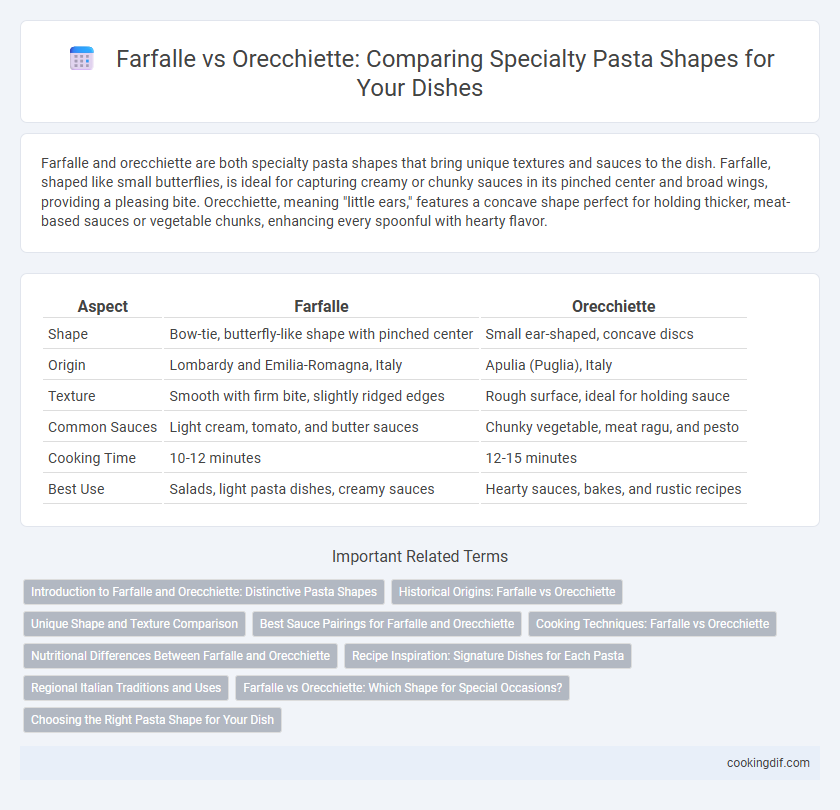Farfalle and orecchiette are both specialty pasta shapes that bring unique textures and sauces to the dish. Farfalle, shaped like small butterflies, is ideal for capturing creamy or chunky sauces in its pinched center and broad wings, providing a pleasing bite. Orecchiette, meaning "little ears," features a concave shape perfect for holding thicker, meat-based sauces or vegetable chunks, enhancing every spoonful with hearty flavor.
Table of Comparison
| Aspect | Farfalle | Orecchiette |
|---|---|---|
| Shape | Bow-tie, butterfly-like shape with pinched center | Small ear-shaped, concave discs |
| Origin | Lombardy and Emilia-Romagna, Italy | Apulia (Puglia), Italy |
| Texture | Smooth with firm bite, slightly ridged edges | Rough surface, ideal for holding sauce |
| Common Sauces | Light cream, tomato, and butter sauces | Chunky vegetable, meat ragu, and pesto |
| Cooking Time | 10-12 minutes | 12-15 minutes |
| Best Use | Salads, light pasta dishes, creamy sauces | Hearty sauces, bakes, and rustic recipes |
Introduction to Farfalle and Orecchiette: Distinctive Pasta Shapes
Farfalle, known for its iconic bow-tie shape, features pinched centers and ruffled edges that hold sauces effectively, making it ideal for creamy and chunky recipes. Orecchiette, translating to "little ears" in Italian, boasts a concave, cup-like form perfect for trapping vegetable or meat-based sauces, enhancing flavor absorption. Both specialty shapes showcase regional Italian traditions, offering unique textures and pairing versatility in pasta dishes.
Historical Origins: Farfalle vs Orecchiette
Farfalle, known for its distinctive bow-tie shape, originated in Northern Italy during the 16th century, where it was traditionally made from simple durum wheat dough to resemble butterflies. Orecchiette hails from the Apulia region in Southern Italy, its name meaning "little ears," shaped by hand to capture sauces effectively, dating back to the 13th century. Both pasta shapes reflect regional culinary heritage, with farfalle linked to ornamental design and orecchiette to rustic, artisanal craftsmanship.
Unique Shape and Texture Comparison
Farfalle features a distinctive bow-tie shape with pinched centers, creating a firm texture that holds sauces effectively, especially creamy and chunky varieties. Orecchiette, shaped like small ears, has a thicker, concave surface that captures thicker, meat-based sauces and vegetable ragus beautifully. The unique shapes of both pastas influence their texture and sauce retention, making them ideal for different culinary uses depending on the desired mouthfeel and flavor absorption.
Best Sauce Pairings for Farfalle and Orecchiette
Farfalle's bow-tie shape and ridged surface make it ideal for creamy sauces like Alfredo or tomato-based sauces with vegetables, as they cling well to the pasta's textured surface. Orecchiette, with its small, cup-like form, excels at holding chunky sauces such as sausage ragu or broccoli rabe with garlic and oil, allowing each bite to capture bursts of flavor. Both shapes complement hearty, rustic sauces but choose Farfalle for richer, smoother sauces and Orecchiette to highlight chunky, vegetable-forward dressings.
Cooking Techniques: Farfalle vs Orecchiette
Farfalle requires precise boiling to maintain its butterfly shape and al dente texture, often paired with lighter sauces that cling to its pinched center. Orecchiette benefits from slightly longer cooking times to achieve a tender yet chewy bite, ideal for capturing thicker, chunkier sauces within its concave form. Both shapes demand specific techniques to optimize sauce adherence and textural contrast, enhancing the overall culinary experience.
Nutritional Differences Between Farfalle and Orecchiette
Farfalle and orecchiette differ nutritionally mainly due to their shape and density, with farfalle typically having a slightly higher carbohydrate content per serving because of its larger surface area that holds more sauce. Orecchiette, being smaller and thicker, often provides slightly more protein and fiber, especially when made from whole grain or durum wheat semolina. Both pasta types offer similar calorie counts but vary in texture and how they impact glycemic index, influencing digestion and energy release.
Recipe Inspiration: Signature Dishes for Each Pasta
Farfalle's butterfly shape pairs perfectly with creamy sauces and fresh vegetables, inspiring dishes like Farfalle Alfredo with peas and pancetta, showcasing its versatility and elegant presentation. Orecchiette's ear-like concave form holds thick, hearty sauces such as broccoli rabe and sausage ragu, creating rustic signature dishes that highlight robust, comforting flavors. Each pasta shape elevates recipes by complementing specific textures and ingredients, making them ideal for distinct culinary experiences.
Regional Italian Traditions and Uses
Farfalle, often called "butterfly pasta," originates from Northern Italy, especially Lombardy and Emilia-Romagna, and pairs well with creamy sauces and light vegetables due to its broad, flat surface that holds sauce effectively. Orecchiette, native to Puglia in Southern Italy, translates to "little ears" and is traditionally served with hearty, rustic ingredients such as broccoli rabe and sausage, reflecting the region's agricultural heritage. Both shapes showcase Italy's regional culinary diversity, with farfalle emphasizing elegant, refined dishes and orecchiette embodying robust, earthy flavors.
Farfalle vs Orecchiette: Which Shape for Special Occasions?
Farfalle, with its distinctive bow-tie shape, offers a charming and elegant presentation ideal for upscale or festive occasions, while orecchiette's ear-like form provides a rustic, hearty appeal that complements robust sauces and traditional dishes. Farfalle's ridged texture captures creamy and light sauces effectively, making it perfect for celebratory meals enhanced with delicate flavors, whereas orecchiette excels with chunky vegetable or meat-based sauces due to its concave shape. Choosing between Farfalle and orecchiette depends on the desired visual impact and sauce pairing to elevate the specialty dining experience.
Choosing the Right Pasta Shape for Your Dish
Farfalle and orecchiette are specialty pasta shapes that excel in different culinary applications due to their unique textures and forms. Farfalle, shaped like small butterflies or bow ties, hold light sauces and pair well with creamy or tomato-based dressings, enhancing dishes with their ridged surface that captures flavor. Orecchiette, meaning "little ears," feature a concave shape ideal for chunky sauces and vegetables, making them perfect for hearty, rustic recipes where the pasta acts as a vessel for thicker, textured ingredients.
Farfalle vs orecchiette for specialty shapes Infographic

 cookingdif.com
cookingdif.com